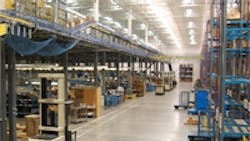Special Feature: Finding Beauty in Retrofitting
Regis Corp. (Edina, Minn.) is one of the larger hair-product distributors in the world. The company owns, franchises or holds ownership interests in more than 13,500 worldwide locations, making it the industry’s global leader in beauty salons, hair restoration centers and cosmetology education. More than 7,000 of those salons and outlets in the eastern part of the U.S., along with operations in the U.K., receive weekly shipments from its distribution center in Chattanooga, Tenn.
“The basic shoe-sorter distribution system we installed in 1998 grew and had worked well for about 10 years,” says Tony Donaldson, general manager. “However, we’ve been growing at a rate of 10% to 12% per year, and the many technological improvements available made the time right for a retrofit.”
He says the cost of repairing the DOS-based system was daunting.
The primary reason for the upgrade to the control management system (CMS) was customer service, says Aaron Pyles, logistics analyst. “Our number-one reason for improving the system was that we wanted to provide even more timely and accurate service to our customers.”
The challenge was in finding ways to incorporate data from the pick-to-light system into parcel tracking and create a messaging functionality that could be routed, wirelessly, to the managers on duty. Also, any changes and enhancements had to be done while the old system was up and running. There could be no slowdown in deliveries.
What Was Needed
Working with engineers from HK Systems (Milwaukee), Regis managers identified the need to get data from the parcel sorter controls, WMS (Logistics Pro, Manhattan Associates, Atlanta) and pick-to-light (CAPE Systems, South Plainfield, N.J.) integrated to achieve real-time parcel tracking.
“We also needed to create a system that would ‘know’ what the parcel weight should be at specific points in its pick, pack and ship cycle,” says Pyles.
Along with a better way to handle its order and replenishment system, Donaldson says it was looking for a better way to communicate what was happening on the floor to supervisors, whether they were on the floor or anyplace else. It opted for a program that could immediately notify
supervisors, via Blackberry communication devices, if there was a problem.
Given the fact that this distribution center ships as many as 12,000 parcels per day, a problem any place along the line for, say, 15 minutes, could create havoc for hours to come. Now, as part of the HK Systems’ CHEC program, if a photo sensor is blocked, or virtually any other problem occurs, managers are immediately alerted via Blackberry.
“We have a selection of about 100 alerts a supervisor can choose from,” explains Donaldson. “Each person can choose only the alerts he needs to know about for his part of the process.”
Creating this intricate and intimate system requires a lot of time up front, says Donaldson. “Anyone considering this part of a retrofit project has to provide bidders a very specific plan to be sure it’s right.”
How it Works
An estimated 7,000 of the 10,000 domestic retail locations in the Regis system are supported from the Chattanooga distribution center. (A similar distribution center, serving a smaller number of West Coast locations, exists in Salt Lake City.) Thousands of hair-care and related products are stored in more than 10,000 pick positions in the 14-aisle, multi-level storage/pick-tolight system.
Order pickers select items and put them into the shipping carton, then put the carton on a takeaway conveyor. As the carton leaves the area, it passes over a check weighing scale, verifying the order before it passes to another picking module.
“The point is,” says Donaldson, “if there is an error, the carton can circulate back to the order picker immediately, not waste time going to a QC check.”
There are several benefits to this way of doing it, he says. One is that associates get immediate feedback if they’ve made an error. “Because the associate is fixing his own errors,” says Donaldson, “we get better fill rates and better accuracy.” Instant feedback goes a long way in helping associates take ownership of every order they pick, he adds.
“When an associate sees QC information posted a day or so after the error, it doesn’t mean much,” says Donaldson. “Since we installed the new system, we’ve not had to terminate anyone for packing quality.”
Accuracy rates are now almost too high to measure. It’s not uncommon to see the accuracy line on the graph bumping against the 100% mark. Donaldson says the distribution center now has an average accuracy rate of about 99.95%.
“You have to understand that we’re shipping to uncommon retail locations,” he says. “When our stores receive the order, they’re quick to get the product on shelf and not so quick to count what’s in the box. It has to be right when it leaves here.”
Donaldson says the new system has worked out so well that a similar operation was recently installed in the company’s distribution center in Salt Lake City. “The company is growing at a rate of 10% to 15% annually,” he says. “Our plan is to stay in these two distribution centers for at least five more years, which will require the automation of our slow-picks area. The previous system could not handle that kind of growth, and the retrofit makes it easy to change and grow.”
| Sources CAPE Systems Manhattan Associates |
